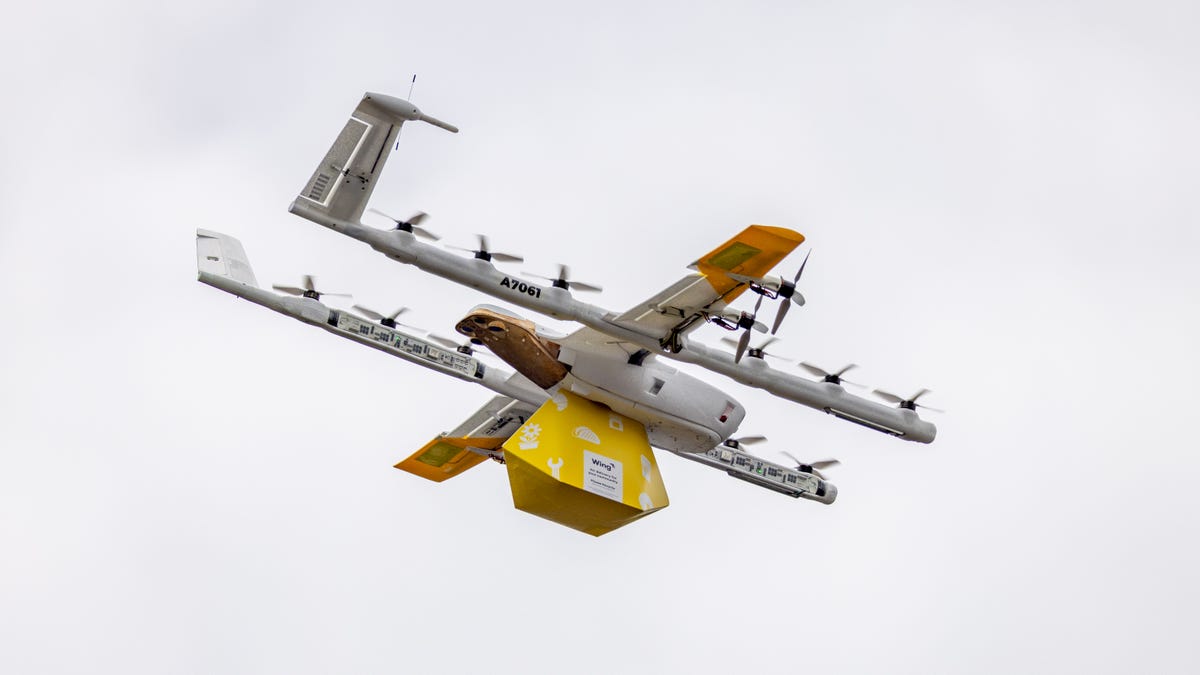Technologies
Expect Smoother Drone Delivery With Wing’s Autoloader
The Alphabet effort publicly demonstrates a launch station it hopes will make it easier for retailers to whisk burritos and aspirin to your home.

Wing, the drone delivery subsidiary from Google parent company Alphabet, has shown publicly for the first time the «autoloader» station it expects will make it significantly easier for retailers to send products through the air to customers.
The autoloader, announced in March and set to be deployed later this year, is a Y-shaped stand that easily fits in a parking space. A company employee hangs a delivery box on a pair of hooks on the autoloader then returns to work. There’s no need to wait for the drone to arrive, because it can snag the package on its own by lowering a yellow hook to the autoloader station.
Adding the autoloader may seem like a minor change, but it paves the way for a potentially massive expansion of drone delivery. Instead of operating isolated base stations, Wing envisions a fleet of drones autonomously dispatched across a network of delivery and charging stations, hopping from one destination to another with a minimum of human intervention. Inexpensive autoloaders make it easier to bring new retailers into the network.
Drone delivery today remains limited by regulators who limit its expansion to a few pockets, but the regulations are maturing along with the technology. Expect millions of us to be within drone delivery range this year from Wing and rival drone delivery efforts from Zipline, Amazon, Drone Express, Matternet, DroneUp, Manna and others.
Wing demonstrated its autoloader technology in a company parking lot at offices in Palo Alto, California, flying packages to a nearby courtyard. It took no special measures to avoid people, trees and cars other than blocking off three parking spots with traffic cones, a sign that Chief Executive Adam Woodworth said shows how mature operations have become.
«We are at the point in this journey where I think that this is a thing that’s going to happen,» Woodworth said. Wing has made more than 340,000 drone deliveries so far with operations in Australia, Finland, Virginia and Texas.
The autoloader has no computer controls or moving parts, but it’s still pretty sophisticated. The two upward pointing poles help guide the drone’s hook, dangling from a string below the hovering drone, to a narrow slot that aligns the hook properly to latch onto the waterproof, recyclable package.
The slot, package and drone hook are all designed to work together. For example, the hook will grab the package only once it’s pushed through the hole on the package. Its round bottom won’t bump back in to regrab it after release.
«It’ll save a lot of time for the user. Instead of going to the store and picking something up, you’re staying at home and waiting for the drone to deliver it to your doorstep,» said Wing marketing chief Jonathan Bass. «For a worker, they can essentially place the package on the auto letter, go back inside and continue working. We think it will save a lot of time.»
The drones, made chiefly of foam, weigh 11 pounds each and can carry a payload up to 3.3 pounds.
«We do expect to introduce aircraft that can deliver larger payloads and some smaller [aircraft] that might be longer range,» Bass said.
Today, Wing’s drones have a range of 6 miles, though bing part of a Wing delivery network, with a mesh of destinations, will extend that since Wing can offer wireless charging pads in more locations.
Will we someday see delivery drones blackening the skies? Not likely, Woodworth believes. Even with current operations launching 1,000 flights a day, which can mean one every 30 seconds or so, drones are unusual.
«The sky is really big,» Woodworth said. «Even at full scale, you’re not going to look up and see tons of airplanes.»
Technologies
Fubo Loses NBCUniversal Channels, Putting Your NBA Games in Jeopardy
Sound the carriage dispute Klaxon: Some network programming has disappeared from the streaming service after content negotiations fell through.

If you’ve noticed your favorite show has recently gone missing from Fubo, it’s probably because an entire block of programming just disappeared from the site’s channel lineup.
The live TV streaming service is engaged in a carriage dispute with NBCUniversal, a media company whose subsidiaries include NBC News, Universal Studios, Peacock, Telemundo and Illumination, among other brands.
On Nov. 21, NBCUniversal pulled all of its networks from Fubo. This is an especially big deal for sports watchers on the streaming service, since the Fubo Sports subscription — which began earlier this year — depends on the licensing agreement with NBCUniversal. However, viewers can still access sports content on networks like ESPN, CBS and ABC.
Fubo released a statement on Tuesday, alleging the media giant is engaging in «discriminatory tactics» that are harming the streamer’s subscribers.
«NBCU is discriminating against Fubo and our subscribers,» the statement says. «They allowed YouTube TV and Amazon Prime to integrate Peacock directly into their channel store, but refused to give Fubo the same rights.»
Don’t miss any of our unbiased tech content and lab-based reviews. Add CNET as a preferred Google source.
Fubo says NBCUniversal is trying to force a multiyear deal for certain channel packages under the media giant’s new spin-off media company, Versant, and that it’s trying to upcharge on the Fubo Sports subscription by adding «expensive, non-sports channels» into the agreement, increasing the cost.
According to NBCUniversal’s website, the Versant brands include CNBC, E!, MS Now, SyFy and USA, among other channels.
NBCUniversal did not respond to a request for comment.
Fubo says that it’s willing to move forward without NBCUniversal content if an agreement cannot be reached.
«Fubo is committed to bringing its subscribers a premium, competitively-priced live TV streaming experience with the content they love,» its statement concludes. «That includes multiple content options, including a sports-focused service, that can be accessed directly from the Fubo app.»
Fubo recently became an affiliate of The Walt Disney Company, following its merger with Hulu’s live TV platform in October. It’s unclear whether this merger affected content agreement negotiations with NBCUniversal. Fubo did not respond to a request for comment on this.
Technologies
Spotify Will Reportedly Get More Expensive in the US Next Year. Here’s What to Expect
The music streaming service will reportedly raise prices again after subscription rate hikes in other regions.

After announcing it is raising prices in regions including Europe, South Asia and Latin America, Spotify is reportedly about to increase prices again in the US.
The US is included in the latest Spotify price hike on its Premium services starting in early 2026, according to the Financial Times, which cited three sources familiar with the streaming music company’s dealings. For now, the least expensive Premium plans in the US start at $12, but the price hike would likely put it in line with the other regions where the Premium plan costs about $14 a month.
Don’t miss any of our unbiased tech content and lab-based reviews. Add CNET as a preferred Google source.
Spotify also offers a Premium Family plan that covers six people in the same household for $20 and plans for students ($6 a month bundled with Hulu) and couples ($17 a month). Spotify also offers a Basic plan that does not include access to audiobooks for $11 a month. A representative for Spotify did not immediately respond to a request for comment.
A steady increase
If the report is accurate, this would be the third price increase on Premium plans in the US since 2023. Before those hikes, Premium plans were $10, but Spotify raised its minimum price by $1 in 2023 then again in 2024.
Just this week, Spotify added the ability to seamlessly import playlists from other music services including Apple Music and Tidal.
Spotify has faced some controversy this year, including some music acts abandoning the platform and some customers canceling subscriptions over advertising for Homeland Security’s ICE program. CNET has a guide for canceling your Spotify subscription.
The company is the market leader among music streaming apps with about 32 percent market share as of the end of 2024.
Technologies
Some Rad Power Bike E-Bike Batteries Can Catch Fire, Consumer Protection Agency Warns
The company declined to offer full replacements or refunds, citing financial constraints.

The US Consumer Product Safety Commission is warning that some lithium‑ion batteries used in certain e‑bikes made by Rad Power Bikes pose a serious fire hazard that could lead to injury or even death. The agency says the batteries, identified by model numbers RP‑1304 and HL‑RP‑S1304, can unexpectedly ignite or explode, especially if the battery or its harness has been exposed to water or debris.
The recall has been marked as a «public health and safety finding» because Rad Power Bikes has declined to offer full replacements or refunds for all consumers, citing financial constraints.
CPSC reports 31 incidents of fire involving these batteries, including 12 cases where property damage totaled approximately $734,500. Some of these fires occurred even when the battery was not in use or charging, but was in storage.
Don’t miss any of our unbiased tech content and lab-based reviews. Add CNET as a preferred Google source.
The batteries were sold as either original or replacement units for several Rad Power Bikes e-bike models and were available through RadPowerBikes.com, Best Buy and independent bike shops nationwide.
«Rad informed the agency that its demand to replace all batteries, regardless of condition, would immediately put Rad out of business, which would be of no benefit to our riders,» the company said in a statement issued with the CPSC warning. «Rad is disappointed that it could not reach a resolution that best serves our riders and the industry at large. Rad reminds its customers to inspect batteries before use or charging and immediately stop using batteries that show signs of damage, water ingress, or corrosion, and to contact Rad so we can support our riders.»
The CPSC’s statement does not apply to all Rad batteries, and does not apply to its Safe Shield or semi-integrated batteries.
Consumers who have one of the affected batteries are urged to stop using it immediately and dispose of it properly via a household hazardous‑waste collection center. Do not place the batteries in standard curb-side recycling or trash bins, and refrain from reselling them.
-

 Technologies3 года ago
Technologies3 года agoTech Companies Need to Be Held Accountable for Security, Experts Say
-

 Technologies3 года ago
Technologies3 года agoBest Handheld Game Console in 2023
-

 Technologies3 года ago
Technologies3 года agoTighten Up Your VR Game With the Best Head Straps for Quest 2
-

 Technologies4 года ago
Technologies4 года agoBlack Friday 2021: The best deals on TVs, headphones, kitchenware, and more
-

 Technologies4 года ago
Technologies4 года agoVerum, Wickr and Threema: next generation secured messengers
-

 Technologies4 года ago
Technologies4 года agoGoogle to require vaccinations as Silicon Valley rethinks return-to-office policies
-

 Technologies4 года ago
Technologies4 года agoOlivia Harlan Dekker for Verum Messenger
-

 Technologies4 года ago
Technologies4 года agoiPhone 13 event: How to watch Apple’s big announcement tomorrow
